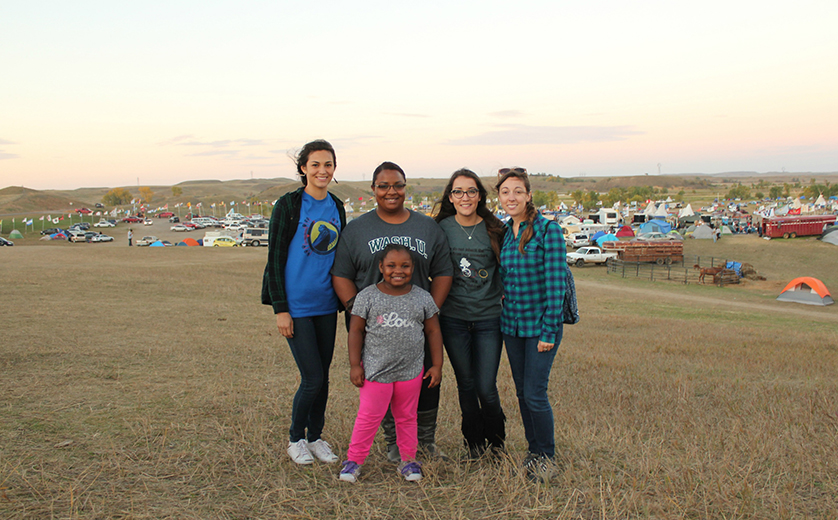When the U.S. Army Corps of Engineers announced recently that it would not be approving a permit required to continue construction of the Dakota Access Pipeline, Becky Plumage had a special reason to celebrate.
She was one of four Brown School students who traveled in October to the Standing Rock Sioux Indian Reservation in North Dakota, where protesters had been camping in an effort to stop plans to tunnel under the nearby Missouri River.
“It was really exciting,” Plumage said of the announcement. But, like other opponents of the pipeline, she’s nervous about what the incoming administration of Donald Trump will mean for the pipeline.
“I’m feeling very uneasy about the new president,” she said. “It’s not over yet, but it’s good news.”
Plumage is a second-year MSW student from Pierre, S.D., and a member of the Gros Ventre and Assiniboine tribes. She decided to visit the protest site after hearing conflicting reports about what was going on there. She was also struck by the unity of different tribes who sent representatives to join the protest.
“This kind of thing doesn’t happen a lot,” Plumage said. “I wanted to see it for myself.”
Molly Tovar (Comanche descent), director of the Brown School’s Kathryn M. Buder Center for American Indian Studies, said the overwhelming support from tribes across the U.S. in opposition to the pipeline was a result of the pipeline’s threat to a common resource: water.
“Water is sacred to all Native people,” she said. “American Indian people believe we are all related to each other — to the plants, animals, earth, sky and humans. Relationship is the kinship obligation and thus this extended family is valued. This obligation rests on the understanding that we have a responsibility to care for all our relatives: the earth.”
Tovar, too, was excited by the government announcement, but cautious.
“It’s something to celebrate for the people who are protesting and have been working so hard,” she said. “The goal of halting the construction was accomplished. But we can’t let our guard down.”
She said the Buder Center will move forward with a symposium planned for Feb. 6 in response to the pipeline. The symposium will also examine other issues surrounding Standing Rock that extend well beyond North Dakota. Tovar cited the desecration of Indian mounds on the St. Louis riverfront, near what had been a proposed site for a new football stadium.
Tovar said the students’ visit to the protests fit well with the mission of the Buder Center.
“Many of the courses and activities offered by the Buder Center focus on community development and leadership in Indian Country,” she said. “This protest allowed students to move from classroom theories to a firsthand examination of a difficult situation.”
“We help train students to be advocates for change,” added Kellie Thompson, assistant director of the center. She noted that the Brown School offers courses in Indian policy, in which students study treaties and interactions with the federal government — issues that are at the heart of the pipeline protests — as well as ways to advocate for change with policymakers.
As a show of solidarity, the American Indian Student Association sponsored Standing with Standing Rock, an informal event on Nov. 17, to educate people on the protest and the underlying issues.
Thompson, a member of the Seneca Nation of Indians, said the center would continue to be active. “The Army Corps’ decision is a huge victory for us as Native people, water protectors, and supporters of Indigenous sovereignty and environmental rights,” she said. “No matter what happens next the Buder Center will continue its support for the water protectors.”
Plumage said her studies in federal law regarding Indians and the history of broken promises were a key motivator for her visit.
“I’m seeing the same thing happening now,” she said of the government actions in North Dakota. “Not consulting on projects that threaten their safety. And the whole lack of media attention early on. It seemed like nobody really cared. That happens a lot with Native American issues.”
Plumage plans to go to law school after graduation. In so doing, she hopes to expand her role as an advocate and effect change in the nation’s courts.
